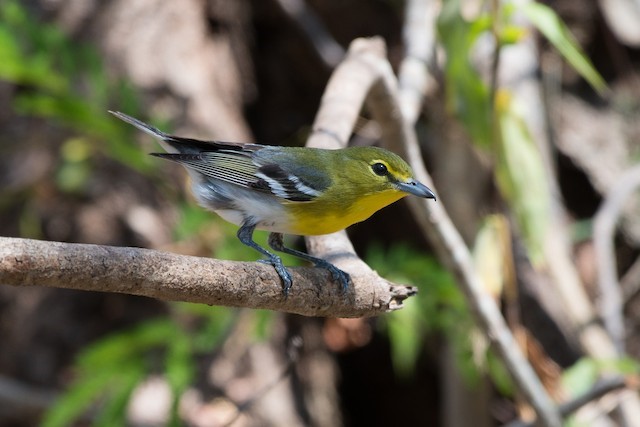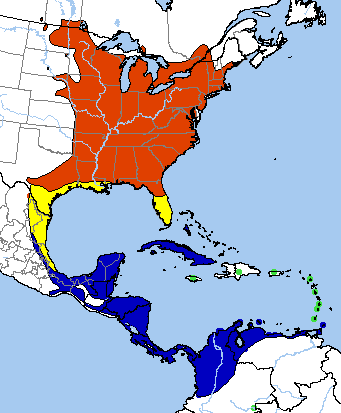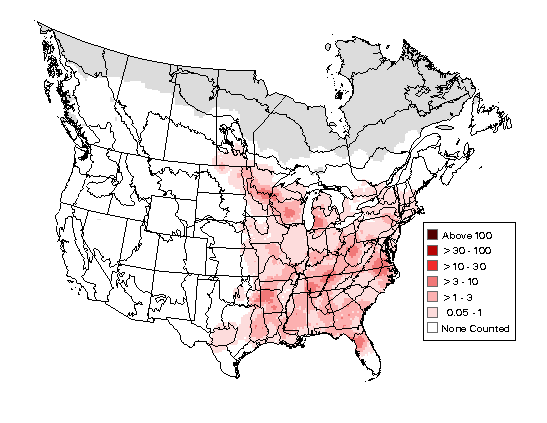Birdfinding.info ⇒ Fairly easy to find during the breeding season in mature deciduous forests across much of the eastern U.S. and adjacent parts of Canada (see Breeding Bird Survey Abundance Map in Notes, below). Especially common as a spring migrant along the Gulf Coast from Texas to Florida.
Yellow-throated Vireo
Vireo flavifrons
Breeds in eastern North America. Winters from eastern Mexico to Colombia, Venezuela, and the West Indies.
Breeding. Mature deciduous and mixed forests from southern Manitoba to southern Quebec and southern Maine, and south to central Texas (possibly into Coahuila, Mexico), the Gulf Coast and central Florida. Fairly common except in the northeastern U.S., where it is uncommon and local.
Nonbreeding. Winters in tropical forests, open woodlands, plantations, and scrub from northeastern Mexico south and east to west-central Colombia, northern Venezuela, and Trinidad, and nearly throughout the West Indies. Most numerous in Central America, from the Yucatán Peninsula to Panama, and on Cuba. Scarce west of the Isthmus of Tehuantepec, in South America, and in the West Indies south and east of Cuba.
Movements. One of the earlier migrant songbirds in spring, it begins arriving in its southern breeding areas in March. Most migration is apparently over the Gulf of Mexico. An infrequent vagrant across the western U.S. and western Mexico.
Identification
A chunky, brightly colored vireo with a heavy, dark gray bill, bold yellow “spectacles,” and dark eyes.
Throat and breast are yellow, contrasting with white belly. Head and upper back are yellow-olive, contrasting with blue-gray lower back and rump. Wings and tail are mixed gray, black, and white, with bold, white wingbars.
Most easily confused with Pine Warbler if not seen well.
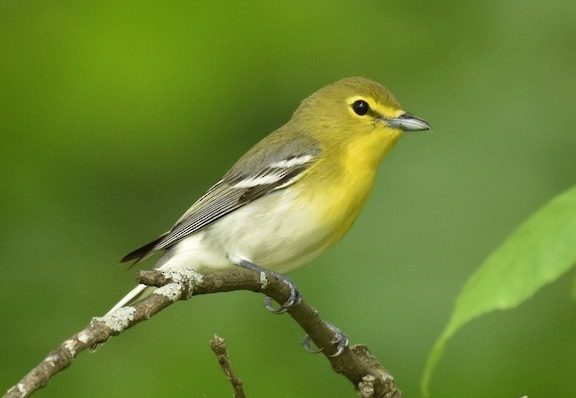
Yellow-throated Vireo. (Dead Creek Wildlife Management Area, Addison, Vermont; June 2, 2018.) © Henry Trombley
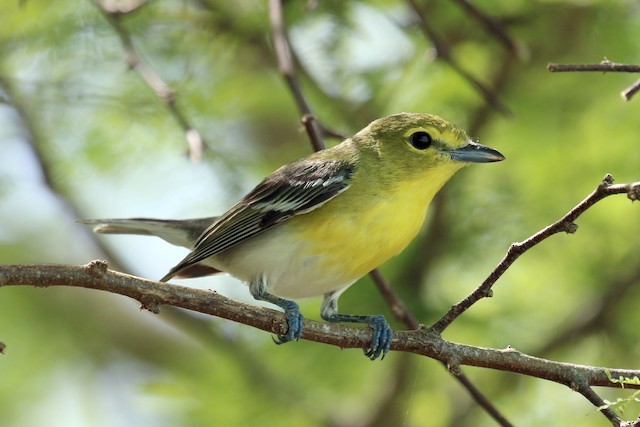
Yellow-throated Vireo. (Laguna Madre Trail, South Padre Island, Texas; April 23, 2018.) © Dan Jones
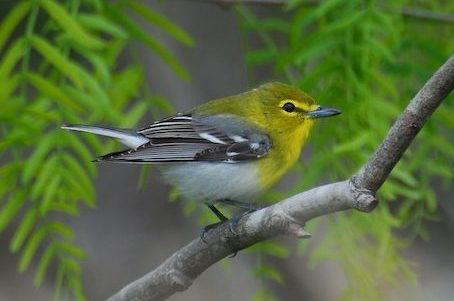
Yellow-throated Vireo, apparently still molting wing feathers. (South Padre Island, Texas; March 10, 2012.) © Mark Esparza
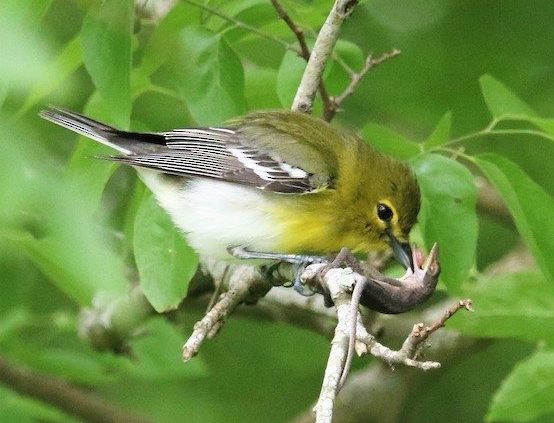
Yellow-throated Vireo, apparently eating an anole. (South Padre Island, Texas; April 8, 2018.) © Ann Vaughan
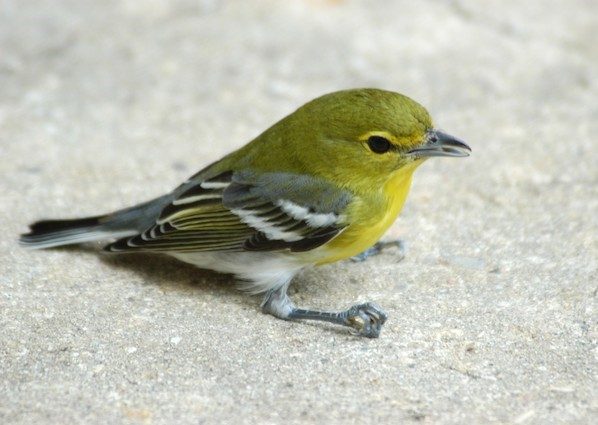
Yellow-throated Vireo. (Slidell, Louisiana; October 20, 2005.) © Marlene Cashen
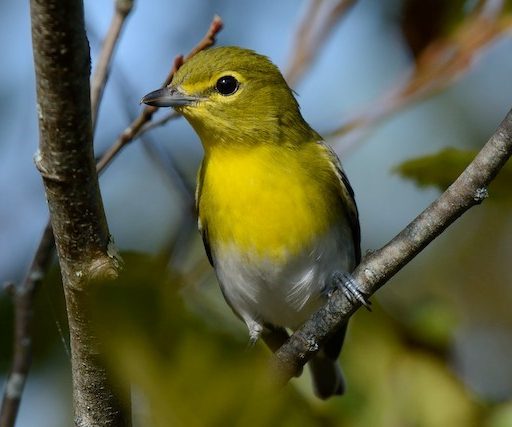
Yellow-throated Vireo. (Meat Camp Environmental Studies Area, Watauga County, North Carolina; September 30, 2017.) © Richard Gray
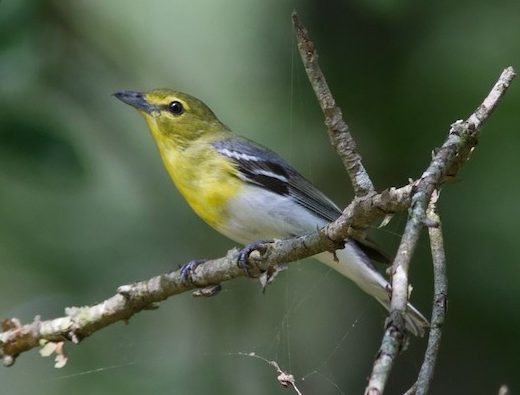
Yellow-throated Vireo. (Sudlersville, Maryland; July 7, 2015.) © Mark R. Johnson

Yellow-throated Vireo, juvenile—note brown wing feathers. (Oakwoods Metropark, Wayne County, Michigan; July 15, 2017.) © Brendan Klick

Yellow-throated Vireo. (Point Ybel Lighthouse Beach Park, Sanibel Island, Florida; April 6, 2018.) © Peter Hawrylyshyn

Yellow-throated Vireo. (Dead Creek Wildlife Management Area, Addison, Vermont; June 2, 2018.) © Henry Trombley
Cf. Pine Warbler. Yellow-throated Vireo and Pine Warbler have similar plumages, but very different bills, voices, and behaviors.
Notes
Monotypic species.
References
Alderfer, J., and J.L. Dunn. 2014. National Geographic Complete Birds of North America (Second Edition). National Geographic Society, Washington, D.C.
Ascanio, D., G.A. Rodriguez, and R. Restall. 2017. Birds of Venezuela. Christopher Helm, London.
Brewer, D. 2018. Yellow-throated Vireo (Vireo flavifrons). In Handbook of the Birds of the World Alive (J. del Hoyo, A. Elliott, J. Sargatal, D.A. Christie, and E. de Juana, eds.). Lynx Edicions, Barcelona. https://www.hbw.com/node/61255. (Accessed November 23, 2018.)
eBird. 2018. eBird: An online database of bird distribution and abundance. Cornell Lab of Ornithology, Ithaca, N.Y. http://www.ebird.org. (Accessed November 23, 2018.)
Fagan, J., and O. Komar. 2016. Peterson Field Guide to the Birds of Northern Central America. Houghton Mifflin Harcourt, New York.
ffrench, R. 2012. A Guide to the Birds of Trinidad & Tobago (Third Edition). Cornell University Press, Ithaca, N.Y.
Garrigues, R., and R. Dean. 2014. The Birds of Costa Rica: A Field Guide (Second Edition). Cornell University Press, Ithaca, N.Y.
Garrido, O.H, and A. Kirkconnell. 2000. Field Guide to the Birds of Cuba. Cornell University Press, Ithaca, N.Y.
Haynes-Sutton, A., A. Downer, R. Sutton, and Y.-J. Rey-Millet. 2009. A Photographic Guide to the Birds of Jamaica. Princeton University Press, Princeton, N.J.
Howell, S.N.G., and S. Webb. 1995. A Guide to the Birds of Mexico and Northern Central America. Oxford University Press, Oxford.
Latta, S., C. Rimmer, A. Keith, J. Wiley, H. Raffaele, K. McFarland, and E. Fernandez. 2006. Birds of the Dominican Republic and Haiti. Princeton University Press, Princeton, N.J.
McMullan, M., and T. Donegan. 2014, Field Guide to the Birds of Colombia (Second Edition). Fundación Proaves de Colombia, Bogotá.
Raffaele, H., J. Wiley, O. Garrido, A. Keith, and J. Raffaele. 1998. A Guide to the Birds of the West Indies. Princeton University Press, Princeton, N.J.
Ridgely, R.S., and J.A. Gwynne. 1989. A Guide to the Birds of Panama (Second Edition). Princeton University Press, Princeton, N.J.
Ridgely, R.S., and G. Tudor. 1989. The Birds of South America, Volume I: The Oscine Passerines. University of Texas Press, Austin.
